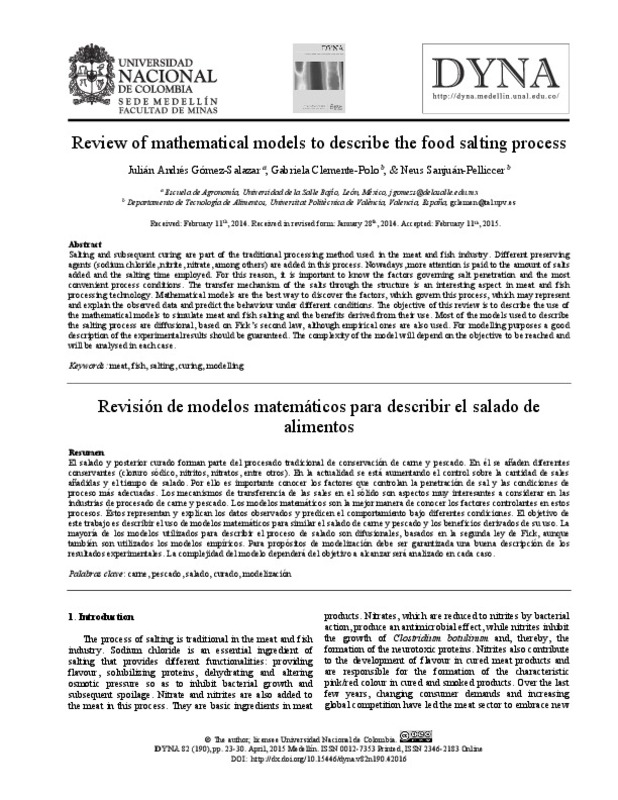JavaScript is disabled for your browser. Some features of this site may not work without it.
Buscar en RiuNet
Listar
Mi cuenta
Estadísticas
Ayuda RiuNet
Admin. UPV
Review of mathematical models to describe the food salting process
Mostrar el registro sencillo del ítem
Ficheros en el ítem
| dc.contributor.author | Gómez Salazar, Julián Andrés
|
es_ES |
| dc.contributor.author | Clemente Polo, Gabriela
|
es_ES |
| dc.contributor.author | Sanjuán Pellicer, María Nieves
|
es_ES |
| dc.date.accessioned | 2016-12-16T12:50:36Z | |
| dc.date.available | 2016-12-16T12:50:36Z | |
| dc.date.issued | 2015-04 | |
| dc.identifier.issn | 0012-7353 | |
| dc.identifier.uri | http://hdl.handle.net/10251/75298 | |
| dc.description.abstract | [EN] Salting and subsequent curing are part of the traditional processing method used in the meat and fish industry. Different preserving agents (sodium chloride, nitrite, nitrate, among others) are added in this process. Nowadays, more attention is paid to the amount of salts added and the salting time employed. For this reason, it is important to know the factors governing salt penetration and the most convenient process conditions. The transfer mechanism of the salts through the structure is an interesting aspect in meat and fish processing technology. Mathematical models are the best way to discover the factors, which govern this process, which may represent and explain the observed data and predict the behaviour under different conditions. The objective of this review is to describe the use of the mathematical models to simulate meat and fish salting and the benefits derived from their use. Most of the models used to describe the salting process are diffusional, based on Fick s second law, although empirical ones are also used. For modelling purposes a good description of the experimental results should be guaranteed. The complexity of the model will depend on the objective to be reached and will be analysed in each case. | es_ES |
| dc.description.abstract | [ES] El salado y posterior curado forman parte del procesado tradicional de conservación de carne y pescado. En él se añaden diferentes conservantes (cloruro sódico, nitritos, nitratos, entre otros). En la actualidad se está aumentando el control sobre la cantidad de sales añadidas y el tiempo de salado. Por ello es importante conocer los factores que controlan la penetración de sal y las condiciones de proceso más adecuadas. Los mecanismos de transferencia de las sales en el sólido son aspectos muy interesantes a considerar en las industrias de procesado de carne y pescado. Los modelos matemáticos son la mejor manera de conocer los factores controlantes en estos procesos. Éstos representan y explican los datos observados y predicen el comportamiento bajo diferentes condiciones. El objetivo de este trabajo es describir el uso de modelos matemáticos para similar el salado de carne y pescado y los beneficios derivados de su uso. La mayoría de los modelos utilizados para describir el proceso de salado son difusionales, basados en la segunda ley de Fick, aunque también son utilizados los modelos empíricos. Para propósitos de modelización debe ser garantizada una buena descripción de los resultados experimentales. La complejidad del modelo dependerá del objetivo a alcanzar será analizado en cada caso | es_ES |
| dc.description.sponsorship | The authors of this paper acknowledge the financial support from CONSOLIDER INGENIO 2010 (CSD2007-00016), Spain. | |
| dc.language | Español | es_ES |
| dc.publisher | Federación de Asociaciones de Ingenieros Industriales de España (FAIIE) | es_ES |
| dc.publisher | Universidad Nacional de Colombia | es_ES |
| dc.relation.ispartof | DYNA | es_ES |
| dc.rights | Reconocimiento - No comercial - Sin obra derivada (by-nc-nd) | es_ES |
| dc.subject | Salting | es_ES |
| dc.subject | Curing | es_ES |
| dc.subject | Salado | es_ES |
| dc.subject | Modelling | es_ES |
| dc.subject | Meat | es_ES |
| dc.subject | Fish | es_ES |
| dc.subject | Carne | es_ES |
| dc.subject | Pescado | es_ES |
| dc.subject | Salazón | es_ES |
| dc.subject | Curado | es_ES |
| dc.subject.classification | TECNOLOGIA DE ALIMENTOS | es_ES |
| dc.title | Review of mathematical models to describe the food salting process | es_ES |
| dc.title.alternative | Revisión de modelos matemáticos para describir el salado de alimentos | es_ES |
| dc.type | Artículo | es_ES |
| dc.identifier.doi | 10.15446/dyna.v82n190.42016 | |
| dc.relation.projectID | info:eu-repo/grantAgreement/MEC//CSD2007-00016/ES/PRODUCTOS CARNICOS PARA EL SIGLO XXI: SEGUROS, NUTRITIVOS Y SALUDABLES/ | es_ES |
| dc.rights.accessRights | Abierto | es_ES |
| dc.contributor.affiliation | Universitat Politècnica de València. Departamento de Tecnología de Alimentos - Departament de Tecnologia d'Aliments | es_ES |
| dc.contributor.affiliation | Universitat Politècnica de València. Escuela Técnica Superior de Ingeniería Agronómica y del Medio Natural - Escola Tècnica Superior d'Enginyeria Agronòmica i del Medi Natural | es_ES |
| dc.description.bibliographicCitation | Gómez Salazar, JA.; Clemente Polo, G.; Sanjuán Pellicer, MN. (2015). Review of mathematical models to describe the food salting process. DYNA. 82(190):23-30. https://doi.org/10.15446/dyna.v82n190.42016 | es_ES |
| dc.description.accrualMethod | S | es_ES |
| dc.relation.publisherversion | https://dx.doi.org/10.15446/dyna.v82n190.42016 | es_ES |
| dc.description.upvformatpinicio | 23 | es_ES |
| dc.description.upvformatpfin | 30 | es_ES |
| dc.type.version | info:eu-repo/semantics/publishedVersion | es_ES |
| dc.description.volume | 82 | es_ES |
| dc.description.issue | 190 | es_ES |
| dc.relation.senia | 292777 | es_ES |
| dc.identifier.eissn | 2346-2183 | |
| dc.contributor.funder | Ministerio de Educación y Ciencia |








